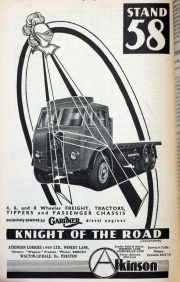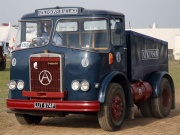Atkinson: Difference between revisions
No edit summary |
|||
| Line 10: | Line 10: | ||
[[image:Im20100808Kem-Atkin-FV.jpg|thumb| Reg No: Q870 FVT. ]] | [[image:Im20100808Kem-Atkin-FV.jpg|thumb| Reg No: Q870 FVT. ]] | ||
[[image:Im20100904DSF-At-OPH515L.jpg |thumb| Reg No: OPH 515L. ]] | [[image:Im20100904DSF-At-OPH515L.jpg |thumb| Reg No: OPH 515L. ]] | ||
Revision as of 16:30, 31 October 2010









Atkinson Lorries Ltd of Frenchwood Works, Preston produced commercial vehicles from 1916 to 1970.
General
Atkinson & Co. was founded in the Frenchwood district of Preston, the cotton town and administrative capital of Lancashire, by two of five brothers, Edward Atkinson (1880–1932) and Henry Birch Atkinson (1882–1921) with assistance from their brother-in-law George Hunt (1870–1950).
The real and effective beginning of the company was in 1907, when the partners decided to capitalise on the need for local engineers to make temporary or permanent repairs to the increasing number of ‘pullcars’ and private motor vehicles on the road.
Edward Atkinson became an expert in the repair and servicing of steam vehicles and was an agent for Alley and MacLellan the forerunner of Sentinel.
By 1912, the organisation had moved to premises in Kendal Street and the number of employees had grown to twenty. In the same year a second, smaller repair centre was opened in Freemason’s Row, Liverpool, to cater for the enormous volume of steam traffic using the docks. Very soon the company made something of a name for itself in the north of England as quality repairers, and the growing number of operators brought new business from far and wide.
1913-1917 For a list of the models and prices of Steam Motor Wagons, Tractors and Ploughs etc. see the 1917 Red Book
1914 Demand for internal road transport grew considerably. Some method of local delivery and collection was needed to supplement the services of the railway companies, and with most of the existing steam wagon manufacturers turning their resources over to munitions production, demand increased further. The Atkinsons, shrewd observers at any time, decided to experiment by making a wagon of their own design
1916 The first Atkinson six-tonne four-wheel steam wagon was produced in Kendal Street and became an instant success. The market enjoyed a short boom period following the Armistice and the Atkinsons, realising the potential, purchased a five-acre site of land near their homes in Frenchwood, on which they intended to erect a new and enlarged factory, solely designed for the production of steam wagons. Together with the field they also bought the 17th century Frenchwood House, with the intention of using it partly as their offices and partly as their personal quarters.
By 1918 the Atkinsons had built up a competent team of engineers and salesmen as well as an enthusiastic and loyal labour force, and were producing wagons competitive in both price and performance.
Henry Atkinson died suddenly in 1921 and the company fell into the hands of his brother Edward. At this time, new ideas and designs were constantly being tried out while production rose to a peak of some three wagons per week, and the total labour force rose to well over a hundred and fifty.
Edward Atkinson had a glorified view of steam and did not acknowledge the warnings when sales began to slow down in the mid-1920s.
Leyland Motors Ltd sold their steam remnants to Atkinson in 1926, followed by Mann in 1929.
There seems to have been various family rivalries at the time and the firm was undoubtedly in difficulties when Edward Atkinson decided to seek help from mine engineers and Pagefield lorry makers, Walker Brothers of Wigan. Under a new arrangement, Walkers manufactured Uniflow engines for Atkinsons, but by this time very few orders were forthcoming.
Edward Atkinson had cancer and was unable to pay any dividends on the preference shares and finally abandoned wagon production in 1929 after a grand total of about 545 Atkinsons had been built. The final years were made possible by a cancellation fee from Manchester Co-op Society, which had ordered a hundred wagons.
The Frenchwood and Freemason’s Row factories closed with the end of the steamers, though the Kendal Street factory remained for repairing and servicing existing wagons.
Edward Atkinson died in 1932 and a year later the firm he co-founded was acquired by London garage owner W. G. Allen, whose father had started Nightingale Garage. Allen was chairman of Atkinson Lorries (1933) Ltd and H. B. Fielding was managing director. Allen had effectively run the firm since 1931, and remained in charge until his death in 1949.
1933 Re-formed as Atkinson Lorries Ltd
1960 Advert for Atkinson dumpers. (of Winery Lane, Walton-le-Dale, nr Preston)
1961 Employees 320 persons. Capital of £10,000. Of Winery Lane, Walton-le-Dale, Preston. A subsidiary of Atkinson Lorries (Holdings) Ltd. [1]
Atkinson merged with Seddons of Oldham in 1970.
- 1974 Vehicles marked as Seddon-Atkinson after Seddon was acquired by International Harvester of America.
Buses
See Atkinson: Buses
Lorries
See Also
Sources of Information
- British Lorries 1900-1992 by S. W. Stevens-Stratten. Pub. Ian Allen Publishing
- Ian Allan - British Buses Since 1900 - Aldridge and Morris
- Mining Year Book 1960. Published by Walter E. Skinner. Advert p33
- [1] Wikipedia

